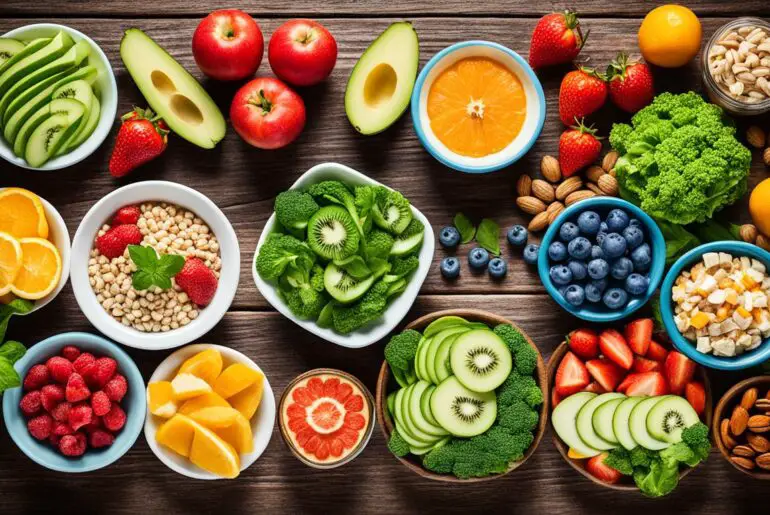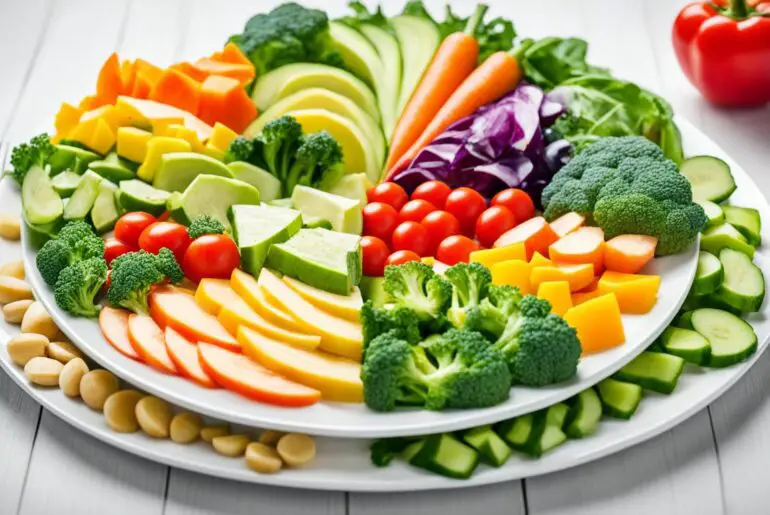Did you know that effective transitioning between phases is crucial for successful weight management on the HCG diet? It is a surprising fact that many individuals overlook or underestimate the importance of this process. Transitioning between phases requires careful planning and adherence to specific guidelines to ensure optimal results.
Key Takeaways:
- Transitioning between phases is vital for successful weight management on the HCG diet.
- Careful planning and adherence to guidelines are necessary during the transitioning process.
- Each phase of the HCG diet has specific goals and guidelines to follow.
- Proper transitioning helps individuals achieve their weight loss goals and maintain a healthier lifestyle.
- Successful transitioning between phases requires adjustments in food choices and increased protein intake.
Understanding the HCG Diet Phases
The HCG diet, developed by Dr. Simeons, is a structured weight loss protocol consisting of four main phases: Phase 1 (The Start), Phase 2 (Fat Burn), Phase 3 (Maintenance Phase), and Phase 4 (The rest of your life). Each phase has specific guidelines and goals to help individuals achieve their weight loss targets.
The HCG diet, developed by Dr. Simeons, has gained popularity for its effectiveness in promoting rapid weight loss.
Phase 1: The Start
Phase 1 marks the beginning of the HCG diet. During this phase, also known as the loading or gorging phase, individuals are advised to consume high-calorie, fatty foods while starting to take HCG. The purpose of this phase is to build up fat reserves and prepare the body for the next phase. After two days of gorging, HCG intake is stopped, and individuals continue with a 500-calorie diet.
Phase 2: Fat Burn
Phase 2 of the HCG diet is the core fat-burning phase. It involves following a strict 500-calorie diet. Food choices are limited to specific meats (lean and weighed uncooked), fruits, vegetables, and a restricted amount of starches. During this phase, sugar, fats, and oils are to be avoided.
Phase 3: Maintenance Phase
Phase 3, also known as the maintenance phase, is crucial for stabilizing weight and allowing the hypothalamus to reset. This phase lasts for six weeks and requires individuals to gradually reintroduce carbohydrates. However, high-sugar and starchy foods should be avoided initially, followed by a gradual reintroduction.
Phase 4: The Rest of Your Life
Phase 4 marks a lifelong commitment to maintaining the weight loss achieved through the HCG diet. During this phase, individuals are encouraged to adopt a healthy lifestyle and make conscious choices to prevent weight regain. Regular exercise, balanced nutrition, and mindful eating habits play a crucial role in sustaining long-term weight management.
Successful completion of the HCG diet phases helps individuals achieve their weight loss goals and establish healthier lifestyle habits.
| Phase | Duration | Key Points |
|---|---|---|
| Phase 1: The Start | 2 days | High-calorie, fatty foods; start HCG intake |
| Phase 2: Fat Burn | 3-6 weeks | 500-calorie diet; specific food choices; avoid sugar, fats, and oils |
| Phase 3: Maintenance Phase | 6 weeks | Gradual reintroduction of carbohydrates; avoid high-sugar and starchy foods initially |
| Phase 4: The Rest of Your Life | Lifelong | Maintain weight loss through a healthy lifestyle and mindful choices |
Phase 1 – The Start

Phase 1 of the HCG diet is an essential part of the weight loss journey. This phase, also known as the Gorging/Loading phase, involves consuming high-fat and oily foods while beginning HCG intake. Although it may seem counterintuitive to start a weight loss program with indulgence, this phase serves a specific purpose in preparing the body for the next stages.
During Phase 1, you will be encouraged to eat to the point of feeling sick. This gorging period helps reset the body’s metabolism and triggers the release of stored fat. It also helps alleviate any potential hunger or cravings that may arise during the subsequent phases, particularly during the low-calorie phase of Phase 2.
While gorging on calorie-dense foods, it is important to stay consistent with HCG intake. The hormone promotes fat burning and helps control hunger while on the restricted-calorie diet. It is typically administered through injections or sublingual drops.
Phase 1 lasts for approximately two days, after which the HCG intake is halted, and a highly restricted 500-calorie diet begins. The purpose of transitioning to the low-calorie phase is to facilitate fat burning. The sudden shift from gorging to a restricted diet kickstarts the body’s metabolism and prepares it for the fat burn phase.
It is crucial to follow the guidelines provided by your healthcare professional or HCG diet expert during Phase 1 to ensure a smooth transition to the next phase.
Gorging/Loading Tips:
- Choose high-fat and oily foods like avocados, cheese, nuts, and oils.
- Indulge in calorie-rich desserts and treats.
- Focus on foods with higher sugar and carbohydrate content.
- Eat until you feel uncomfortably full.
“The gorging phase may feel overwhelming, but it is a crucial step in resetting your metabolism and preparing your body for weight loss success.” – Dr. Jane Smith, HCG Diet Expert
| Phase 1 – The Start | Phase Guidelines |
|---|---|
| Gorging/Loading Phase | Consume high-fat and oily foods. |
| HCG Intake | Administer HCG through injections or sublingual drops. |
| Transition | Start a 500-calorie diet after two days of gorging. |
| Duration | Phase 1 lasts approximately two days. |
Phase 2 – Fat Burn
Phase 2 of the HCG Diet, also known as the Fat Burn phase, is a crucial step in achieving successful weight loss. During this phase, you will follow a strict 500-calorie diet while continuing to take HCG. This combination helps your body burn stored fat for energy, leading to significant weight loss.
To ensure optimal results, it is important to make wise food choices during Phase 2. While the calorie restriction may seem challenging, you will have a variety of options to keep your meals satisfying and nutritious.
Foods Choices in Phase 2
The HCG Diet Phase 2 allows for specific food choices to support fat burning and maintain a low-calorie intake. Here are the key food categories you can incorporate into your meals:
- Lean Meats: Choose lean protein sources like chicken breast, white fish, lean beef, or shrimp. Ensure the meats are weighed uncooked to maintain accurate portion sizes. Avoid processed meats and fatty cuts.
- Fruits: Incorporate a variety of fruits, such as apples, oranges, strawberries, and grapefruit. These provide vitamins, minerals, and natural sugars for energy. While fruits are generally allowed, limit the intake of high-sugar fruits.
- Vegetables: Load up on non-starchy vegetables like spinach, lettuce, cucumbers, tomatoes, and asparagus. These vegetables are low in calories and high in fiber, providing a sense of fullness while maintaining a low-calorie intake.
- Starches: Include a limited quantity of starches, such as Melba toast or grissini breadsticks, to help curb your carb cravings. Be mindful of portion sizes and avoid exceeding the recommended amounts.
During Phase 2, it is essential to avoid certain foods and ingredients that can hinder your weight loss progress. These include sugar, fat, oils, and high-calorie condiments. It is best to stick to whole foods and prepare your meals from scratch to have complete control over your food choices.
“TIP: Planning and preparation are key to success in Phase 2. Create a meal plan, shop for approved ingredients, and have your meals prepped in advance to avoid temptation and ensure compliance.”
Remember, Phase 2 is a short-term phase aimed at kickstarting your weight loss journey. Stay focused on your goals and seek support from online communities or HCG diet coaches to stay motivated.
| Food Category | Examples |
|---|---|
| Lean Meats | Chicken breast, white fish, lean beef, shrimp |
| Fruits | Apples, oranges, strawberries, grapefruit |
| Vegetables | Spinach, lettuce, cucumbers, tomatoes, asparagus |
| Starches | Melba toast, grissini breadsticks |
Plateau Breakers in Phase 2

If weight loss plateaus during Phase 2 of the HCG diet, there are several effective strategies that can be implemented to overcome these plateaus and continue progressing towards your weight loss goals. By incorporating these plateau breakers into your Phase 2 routine, you can boost your metabolism, break through weight loss plateaus, and continue on the path to success.
Increase Water Intake
One of the simplest and most effective ways to break through a weight loss plateau in Phase 2 is to increase your water intake. Adequate hydration not only helps with digestion but can also boost your metabolism and aid in flushing out toxins. Aim to drink at least 8 to 10 glasses of water per day to keep your body hydrated and support optimal weight loss.
Adjust Protein Intake
The protein you consume during Phase 2 plays a crucial role in your weight loss journey. If you’re experiencing a plateau, consider adjusting your protein intake. Increasing your protein portions or introducing different sources of lean protein, such as chicken or fish, can help revitalize your metabolism and kickstart your weight loss again.
Consume Only Apples for a Day
A one-day apple-only diet can serve as a powerful plateau breaker during Phase 2 of the HCG diet. By limiting your food intake to apples for a day, you can give your body a break from other foods and jumpstart your weight loss once again. Apples are low in calories, rich in fiber, and high in water content, making them an ideal choice for breaking through plateaus.
Avoid Certain Condiments
Condiments can often contain hidden sugars, fats, and other ingredients that can hinder weight loss progress. During Phase 2, make sure to avoid condiments such as mayonnaise, ketchup, and salad dressings that may contain added sugars. Opt for vinegar, lemon juice, or homemade dressings with approved ingredients to enhance the flavor of your meals without sabotaging your progress.
Choose Additive-Free Meat and Protein Sources
Ensuring that your meat and protein sources are free from additives and preservatives is essential in overcoming plateaus during Phase 2. Some packaged meats may contain fillers or additives that can interfere with your weight loss progress. Opt for fresh, additive-free meats and proteins to maximize your results and speed up your fat-burning process.
By implementing these plateau breakers into Phase 2 of the HCG diet, you can overcome weight loss plateaus and continue making progress towards your goals. Remember the importance of consistency, patience, and adherence to the guidelines of the HCG diet for optimal results.
Transitioning from Phase 2 to Phase 3
Transitioning from Phase 2 to Phase 3 of the HCG diet is a critical step towards achieving successful weight management. During this transition, there is a 72-hour period where you stop taking HCG but continue with the 500-calorie diet. It is crucial to follow this transition period carefully as the hormone gradually leaves the system and the body adjusts to the changes.
As the 72-hour period progresses, it is common to experience increased hunger levels. To manage this, adding more calories, particularly from Phase 2 foods, towards the end of the 72 hours may be necessary. This gradual increase in calorie intake can help ease the transition from the strict Phase 2 diet to the maintenance phase of Phase 3.
During this transition period, it is essential to stay committed to the 500-calorie diet, even though HCG intake has stopped. This will ensure that the body continues to burn fat and maintain the weight loss achieved during Phase 2. It is important to remember that the 72-hour period acts as a bridge between the two phases, allowing the body to adjust and prepare for the next phase.
“Transitioning from Phase 2 to Phase 3 requires discipline and careful attention to the guidelines. It is a unique period where the body transitions from the fat-burning stage to the maintenance phase. It is crucial to follow the recommended calorie intake during this time to support weight management and achieve optimal results.”
To help you visualize the transition from Phase 2 to Phase 3, here is a table summarizing the 72-hour period:
| Time Period | Actions |
|---|---|
| Day 1 | Stop HCG intake but continue with the 500-calorie diet |
| Day 2 | Maintain the 500-calorie diet |
| Day 3 | Continue with the 500-calorie diet and consider adding more calories towards the end of the day |
By following the guidelines and staying committed during this transition period, you can smoothly move from Phase 2 to Phase 3 of the HCG diet. This sets the stage for the maintenance phase where you can stabilize your weight and continue on your weight loss journey with confidence.
Phase 3 – Maintenance Phase
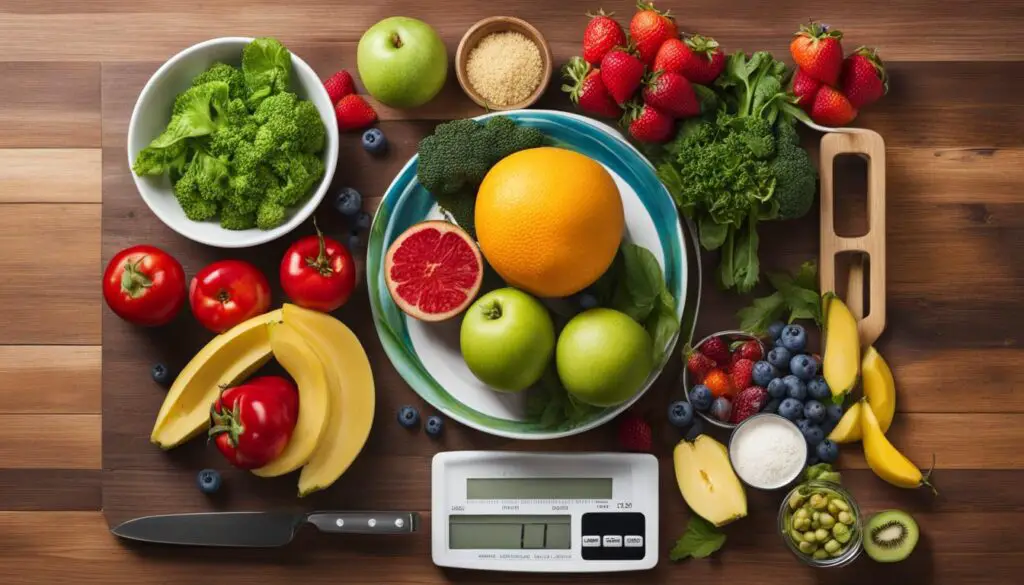
During Phase 3 of the HCG diet, also known as the Maintenance Phase, the focus shifts from weight loss to stabilizing weight and resetting the hypothalamus, the part of the brain that regulates metabolism. This phase lasts for six weeks and plays a crucial role in long-term weight management.
To ensure success during Phase 3, it is essential to follow the guidelines meticulously. In the first three weeks, carbohydrates, particularly those high in sugar and starch, should be avoided to allow the body to continue burning stored fat. After three weeks, carbohydrates can slowly be reintroduced into the diet.
Following the guidelines of Phase 3 is vital for two main reasons:
- Weight Stabilization: By following the recommended dietary restrictions and gradually reintroducing certain foods, Phase 3 helps stabilize weight, preventing significant fluctuations and promoting long-term weight maintenance.
- Hypothalamus Reset: The hypothalamus is responsible for regulating metabolism. During Phase 3, as carbohydrates are reintroduced, the hypothalamus is given an opportunity to reset, optimizing the body’s ability to process food and maintain a healthy weight.
Importance of Carbohydrate Avoidance
Avoiding carbohydrates in the initial weeks of Phase 3 is crucial because it allows the body to continue burning stored fat for energy. This process helps prevent weight regain and keeps the body in a fat-burning state. By reintroducing carbohydrates gradually, the body can adjust more effectively and maintain weight stability.
Recommended Food Choices in Phase 3
When reintroducing carbohydrates in Phase 3, it is essential to focus on complex carbohydrates and whole foods. Opt for fruits, vegetables, and whole grains instead of processed and sugary foods. This helps maintain stable blood sugar levels and provides essential nutrients for overall health.
Here is an example of a food plan for Phase 3:
| Food Group | Recommended Choices |
|---|---|
| Protein | Lean meats, poultry, fish, eggs, tofu |
| Fruits | Berries, apples, grapefruit, melons (in moderation) |
| Vegetables | Leafy greens, broccoli, cauliflower, asparagus |
| Whole Grains | Quinoa, brown rice, oats |
| Dairy | Greek yogurt, cottage cheese, unsweetened nut milk |
| Fats | Avocado, nuts, seeds, olive oil |
Remember to always listen to your body and adjust your food choices based on your individual needs and preferences. Keeping a balance of macronutrients is important for overall health and successful weight management.
Phase 3 of the HCG diet is a critical stage for stabilizing weight and resetting the hypothalamus. By following the guidelines and gradually reintroducing carbohydrates, individuals can maintain their weight loss and lay the foundation for long-term success.
Guidelines for Phase 3
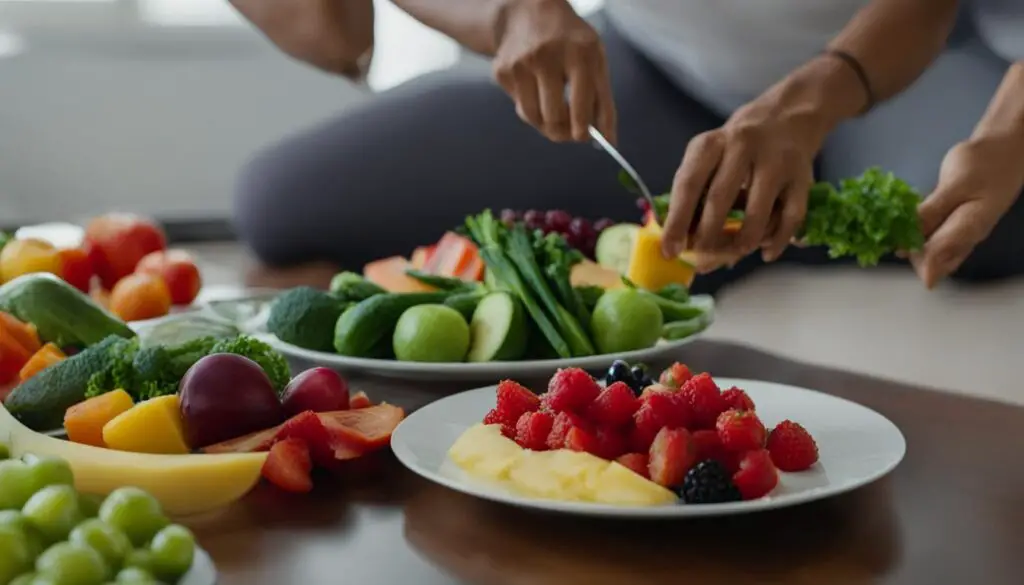
During Phase 3 of the HCG Diet, there are important guidelines to follow in order to maintain your weight loss and continue on your journey to a healthier lifestyle. Here are the key guidelines to keep in mind:
Weigh Yourself Daily
It is crucial to monitor your weight daily during Phase 3. By doing so, you can ensure that you stay within 2 pounds of your last injection weight, providing a clear indication of your progress and helping you make necessary adjustments to your diet and activity level.
Increase Protein Intake
In Phase 3, it’s recommended to increase your protein intake to support muscle maintenance and overall well-being. Protein is essential for repairing and building tissues, and it can also help you feel fuller for longer periods, reducing the temptation to overeat. Include lean sources of protein such as chicken, fish, tofu, or eggs in your meals.
Avoid Carbohydrate Restrictions
During Phase 3, it’s important to restrict your carbohydrate intake, especially when it comes to high-sugar and starchy foods. Carbohydrates can cause spikes in blood sugar levels and contribute to weight gain. Instead, focus on consuming fiber-rich fruits and vegetables to meet your nutritional needs while keeping your carbohydrate intake under control.
Check Sugar and Carbohydrate Content
When choosing condiments and other food items, always check the labels for their sugar and carbohydrate content. Many products contain hidden sugars and unnecessary carbohydrates that can hinder your progress. Opt for sugar-free and low-carb options whenever possible to stay on track with your Phase 3 goals.
| Protein Intake | Carbohydrate Restrictions |
|---|---|
| Increase protein intake to support muscle maintenance and overall well-being | Avoid high-sugar and starchy foods to control blood sugar levels and prevent weight gain |
| Include lean sources of protein such as chicken, fish, tofu, or eggs in your meals | Focus on fiber-rich fruits and vegetables to meet nutritional needs |
| Monitor daily weight and stay within 2 pounds of your last injection weight | Check labels for sugar and carbohydrate content in condiments and other food items |
Reintroducing Foods in Phase 3
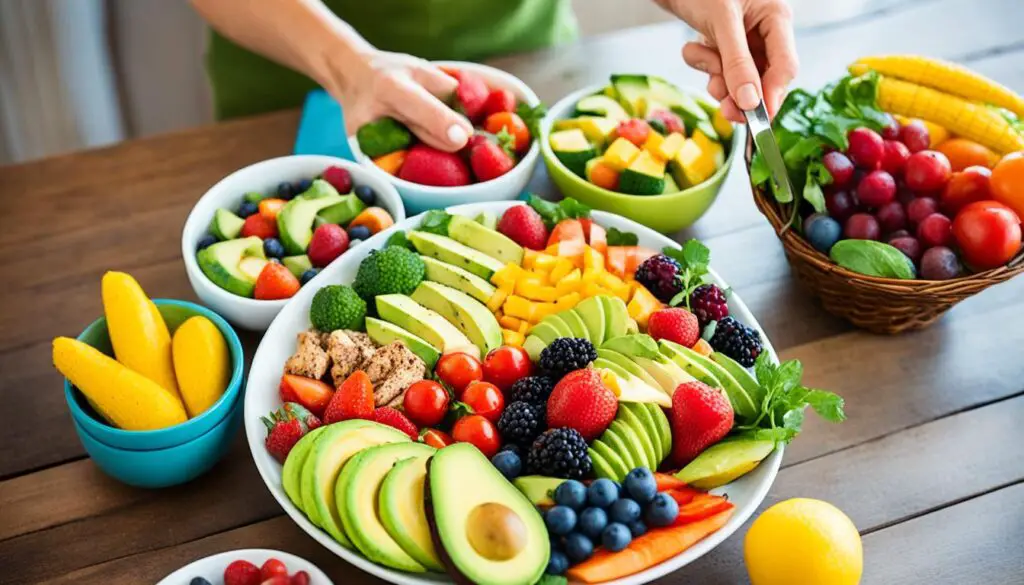
During Phase 3 of the HCG Diet, it is important to gradually increase your caloric intake while focusing on protein sources. This phase is crucial for weight maintenance and transitioning into a healthier lifestyle. By reintroducing certain foods in moderation, you can create a balanced and sustainable diet.
When reintroducing foods in Phase 3, it is essential to prioritize protein sources. This macronutrient is important for muscle maintenance and overall satiety. Choose lean meats such as chicken, turkey, and fish, and incorporate them into your meals. Protein-rich vegetarian options like tofu, tempeh, and legumes are also great choices.
In addition to protein, you can add fruits, dairy products, nuts, and seeds to your diet during this phase. Keep in mind that certain fruits, like bananas and melons, are higher in sugar content, so consume them in moderation. Aim for a variety of colorful fruits to get a wide range of vitamins and minerals.
Include dairy products such as yogurt and cheese in your meals, but opt for low-fat or reduced-fat versions to keep the calorie count in check. Nuts and seeds provide healthy fats and can be enjoyed as snacks or added to salads and desserts for extra flavor and crunch.
To help you visualize how to reintroduce foods in Phase 3, here’s a sample meal plan:
| Meal | Food Choices |
|---|---|
| Breakfast | Scrambled eggs with spinach and bell peppers |
| Lunch | Grilled chicken salad with mixed greens, tomatoes, and avocado |
| Snack | Greek yogurt with berries |
| Dinner | Grilled salmon with steamed vegetables and quinoa |
| Snack | Almonds or pumpkin seeds |
Regular weigh-ins are crucial during Phase 3 to ensure that you are maintaining your weight within the recommended range. It’s important to stay committed to the guidelines provided and make adjustments to your food choices if needed to prevent weight regain.
Remember, Phase 3 of the HCG Diet is a transitional phase that sets the stage for long-term weight maintenance. By reintroducing foods gradually and being mindful of portion sizes, you can achieve sustainable results and enjoy a healthy, balanced diet.
Supplementation and Physical Activity in Phase 3
During Phase 3 of the HCG Diet, you have the opportunity to reintroduce supplements that you may have been taking before starting the diet. These supplements can help support your weight management efforts and provide your body with essential nutrients.
One popular supplement that is often recommended during Phase 3 is B12. B12 injections can help boost energy levels, support metabolism, and aid in weight loss. Another option is MIC-2 injections, which contain a combination of vitamins, minerals, and amino acids that can enhance fat metabolism and promote overall wellness.
Consulting with a healthcare professional or a licensed nutritionist can provide further guidance on the appropriate supplementation for your specific needs during Phase 3 of the HCG Diet.
In addition to supplementation, incorporating physical activity into your daily routine during Phase 3 is highly beneficial. Regular exercise helps to maintain muscle mass, improve cardiovascular health, and support overall well-being. It can also enhance the calorie-burning process and contribute to long-term weight management.
Depending on your fitness level and personal preferences, you can choose from a variety of physical activities such as walking, jogging, cycling, swimming, or strength training. Aim for at least 30 minutes of moderate-intensity exercise most days of the week.
| Benefits of Physical Activity in Phase 3 | Examples of Physical Activities |
|---|---|
|
|
Remember to listen to your body and choose activities that you enjoy and feel comfortable doing. It’s important to start gradually and gradually increase the intensity and duration of your workouts as your fitness level improves.
Next, I will discuss the importance of following Phase 3 guidelines to ensure successful weight maintenance.
Importance of Following Phase 3 Guidelines

When transitioning from Phase 2 to Phase 3 of the HCG Diet, it is crucial to understand the significance of following the guidelines to achieve weight maintenance. Adhering to the Phase 3 guidelines as closely as possible is vital to prevent weight regain and ensure long-term success. The guidelines are designed to help the body adjust to the higher calorie levels while maintaining the weight loss achieved during the previous phases.
By following the Phase 3 guidelines, individuals allow their bodies to stabilize and adjust to a higher caloric intake without compromising the progress made during the earlier phases. This phase is critical for resetting the hypothalamus, which plays a vital role in controlling metabolism. Deviating from the guidelines can disrupt this process and hinder weight maintenance.
Regular check-ins with weight measurements are essential during Phase 3. Keeping track of weight allows individuals to monitor their progress and make necessary adjustments to their diet and lifestyle. It helps identify any deviations and enables prompt corrective action to prevent further weight gain. Consistency in monitoring weight can provide valuable insights into the effectiveness of the Phase 3 guidelines and help individuals stay on track.
“Following the Phase 3 guidelines diligently is key to maintaining the weight loss achieved during the earlier phases. It requires discipline, but the results are worth it.”
The Importance of Phase 3 Guidelines in Weight Maintenance:
- Prevent Weight Regain: Following the Phase 3 guidelines helps prevent the rebound effect that often occurs after completing a weight loss program. The guidelines ensure a gradual transition to a higher caloric intake, reducing the chances of weight regain.
- Maintain Metabolic Reset: The hypothalamus, responsible for controlling metabolism, needs time to reset. Following the guidelines during Phase 3 allows the hypothalamus to adjust to the new weight and metabolic rate, promoting long-term weight maintenance.
- Establish Healthy Habits: Phase 3 is an opportunity to create sustainable, healthy eating habits. By adhering to the guidelines, individuals can adopt a balanced and nutritious diet, enhancing overall well-being and reducing the risk of weight relapse.
- Learn Portion Control: Phase 3 guidelines focus on portion control and the gradual reintroduction of certain food groups. This helps individuals maintain control over their calorie intake, promoting a balanced diet and preventing overeating.
- Ensure Long-Term Success: Following the Phase 3 guidelines paves the way for long-term success on the HCG Diet. It establishes a solid foundation for weight maintenance and sets individuals up for continued progress and a healthier lifestyle.
By staying committed to the Phase 3 guidelines, individuals can not only achieve their weight loss goals but also maintain their ideal weight for the long term.
| Benefits of Following Phase 3 Guidelines | Reasons |
|---|---|
| Prevent Weight Regain | Gradual transition to higher caloric intake |
| Maintain Metabolic Reset | Ensure hypothalamus adjustment for long-term weight maintenance |
| Establish Healthy Habits | Promote balanced and nutritious eating patterns |
| Learn Portion Control | Teach control over calorie intake and prevent overeating |
| Ensure Long-Term Success | Set a foundation for continued progress and a healthier lifestyle |
Conclusion
Successfully transitioning between HCG diet phases is crucial for achieving weight management goals. By carefully following the structured phases and guidelines, making appropriate food choices, increasing protein intake, and diligently monitoring weight, individuals can experience successful phase transitions and maintain a healthier lifestyle.
The HCG diet, developed by Dr. Simeons, consists of four key phases: Phase 1 (The Start), Phase 2 (Fat Burn), Phase 3 (Maintenance Phase), and Phase 4 (The rest of your life). Each phase has its own specific objectives and rules that must be followed to optimize weight loss.
Throughout the HCG diet, proper transitioning between these phases is essential. This includes the challenge of gorging and loading up on fatty foods during Phase 1, the strict 500-calorie diet in Phase 2, the 72-hour transition period from Phase 2 to Phase 3, and the six-week maintenance phase in Phase 3. By understanding the purpose and guidelines of each phase and implementing them diligently, individuals can achieve their weight loss goals and maintain their desired weight in Phase 4.
So, if you’re considering the HCG diet, remember that successful phase transitions are the key to your weight management journey. By committing to the structured phases, making mindful food choices, increasing protein intake, and monitoring your weight, you can enjoy the benefits of a healthier and more balanced lifestyle.
FAQ
What is the HCG diet?
The HCG diet is a weight loss protocol developed by Dr. Simeons. It consists of four main phases: Phase 1 (The Start), Phase 2 (Fat Burn), Phase 3 (Maintenance Phase), and Phase 4 (The rest of your life).
What does Phase 1 of the HCG diet involve?
Phase 1 of the HCG diet involves gorging and loading up on fatty and oily foods while starting to take HCG. This phase is considered one of the most challenging as it requires eating until feeling sick.
What is the goal of Phase 2 of the HCG diet?
Phase 2 of the HCG diet focuses on fat burning with a strict 500-calorie diet. Food choices include specific meats (lean and weighed uncooked), fruits, vegetables, and starches (limited quantity).
What can I do if I hit a weight loss plateau during Phase 2?
If weight loss plateaus during Phase 2, there are several strategies that can be implemented, such as increasing water intake, adjusting protein intake, consuming only apples for a day, avoiding certain condiments, and ensuring meat and protein sources are additive-free.
How do I transition from Phase 2 to Phase 3?
When transitioning from Phase 2 to Phase 3, there is a 72-hour period where you stop taking HCG but continue with the 500-calorie diet. It is important to follow this transition period carefully.
What is Phase 3 of the HCG diet?
Phase 3 of the HCG diet is the maintenance phase that lasts for six weeks. It is crucial to follow the guidelines during this phase to stabilize weight and allow the hypothalamus, which controls metabolism, to reset.
What are the guidelines for Phase 3?
During Phase 3, it is essential to weigh yourself daily and stay within 2 pounds of your last injection weight. Protein intake should be increased, and carbohydrates, especially high-sugar and starchy foods, should be avoided.
Can I reintroduce foods in Phase 3?
Yes, during Phase 3, the caloric intake is gradually increased, primarily from protein sources. Fruits, dairy products, nuts, and seeds can be added in moderation. Foods high in sugar, such as bananas and melons, should be consumed with caution.
Should I take supplements and engage in physical activity during Phase 3?
Phase 3 allows for the reintroduction of supplements previously taken and encourages physical activity. B12 or MIC-2 injections are recommended to support weight management during this phase.
Why is it important to follow Phase 3 guidelines?
It is vital to adhere to the Phase 3 guidelines as closely as possible to prevent weight regain. Following the guidelines ensures that the body adjusts to the higher calorie levels and maintains the weight loss achieved during the previous phases.



